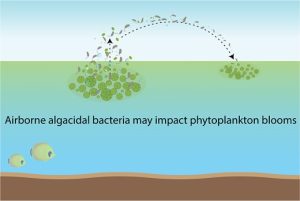Waves of Migration?
That's how populations of bacteria travel thousands of kilometers over the ocean
Dr. Naama Lang-Yona is studying the transport of microorganisms in the atmosphere and their effects on nature and humans.
We’re all aware of the bacteria in our bodies, how there are links between diseases and bacteria and viruses, and how pandemics spread. Those tiny organisms, found everywhere on the Earth’s surface, are also important in influencing various processes including soil health, pollutant decomposition, agricultural growth, and carbon sequestration. Dr. Naama Lang-Yona from the Faculty of Civil and Environmental Engineering is addressing a lesser-known aspect related to those microorganisms – their distribution mechanisms, survival, and activity in the atmosphere.
Dr. Lang-Yona’s research focuses, among other things, on the mutual influence (bio-exchanges) of the oceans and the atmosphere on the transportation of bacteria over the oceans. Bacteria constitute about 70% of marine biomass and play a very significant role in biogeochemical processes. Although they impact carbon, nitrogen, and sulfur cycles, little is known about their distribution and role in the environment.
In an article published this year, Dr. Lang-Yona and her colleagues at the Weizmann Institute of Science, Dr. J. Michel Flores, Prof. Ilan Koren, and Prof. Assaf Vardi, describe active bacteria found above the oceans. One of these bacteria, Roseovarius nubinhibens, is capable of killing algae. The research found that this bacterium is released into the atmosphere with the aerosol rising from ocean waters during the blooming of Emiliania huxleyi algae. While in the air, it managed to survive, retaining its ability to infect algae. These capabilities allow such pathogenic bacteria to expand their infection range and impact algal blooms spreading over thousands of square kilometers in the ocean.
Dr. Lang-Yona has published articles focusing on genomic mapping of airborne microbial populations (also termed bioaerosols) which traverse common thousands of kilometers above oceans, the dissemination of antibiotic-resistant genes through the air, the impact of climate change and air pollution on respiratory allergens (known as aero-allergens), the airborne transport of endotoxins, the characterization of different microorganisms in the environment, such as allergenic cyanobacteria, and the spread of airborne plant pathogens, and more.
Currently, Dr. Lang-Yona and her team are conducting research on the distribution of bacteria via dust storms reaching Israel all the way from the Sahara and Arabian deserts. Their aims are to elucidate the survival mechanisms and distinctive traits of these bacteria. In addition, they examine the idea that along with the bacteria carried and dispersed in the air, antibiotic resistance may also disperse and propagate across continents.
These studies have dramatic implications for understanding the transmission of diseases and pandemics, as well as for devising strategies to impede their dissemination.
For the full article: Impact of airborne algicidal bacteria on marine phytoplankton blooms | The ISME Journal | Oxford Academic (oup.com)




